143. Black-chested Snake-eagle (Formerly known as Black-breasted Snake-eagle) Circaetus pectoralis (Swartborsslangarend)
ORDER ACCIPITRIFORMES. Family: Accipitridae
Descpription
Sexes alike. The main identification character of this bird is its dark brown head and chest, to which it owes its name. Paler on the upperparts and noticeably rufous chest. Unfeatherd lower legs, in flight plain white underparts and mainly white underwings apart from dark barring on the flight feathers and a narrow barred tail. The eye is bright yellow. Yellow beak.
Sometimes confused with larger Martial Eagle but does not have the black chest spots. In flight easily differentiated by white (not brown) underwings with narrow black bars across secondaries.
Juvenile: Resembles drab, ragged adult, with extensive brown spotting on belly and some white remaining on breast. Upper parts warm brown, with pale-edged back feathers and wing coverts giving scaled appearance. Large yellow eyes. In flight, underwing coverts brown; flight feathers pale with 3 distinct narrow bars.
Juveniles are smiliar to Brown Snake Eagle but have a more rufous- or yellow-brown look, particularly on the underparts. At the age of six months a few black feathers appear on the chest and from the age of ten months white feathers appear on the belly. Adult plumage usually attained after three years.
Distribution
From Ethiopia and southern Democratic Republic of Congo to northern South Africa.
Habitat
It lives in a variety of habitats, ranging from semi-desert and open grassland to Karoo scrub and closed deciduous woodland.
Diet
They feed mostly on snakes (eg. cobras, adders, boomslangs, grass snakes), but will also prey on lizards, small mammals, frogs, rodents and insects.
Breeding
Monogamous. A territorial solitary nester, the nest is built by both sexes, consisting of a saucer-shaped structure of sticks, lined with green leaves and placed in the canopy of a flat-topped Acacia. The egg-laying season in South Africa is from June-August, while elsewhere in southern Africa it is from March-October, peaking from June-October. It almost invariably lays a single egg, which is mainly incubated by the female for about 51-52 days. The chick is brooded and fed by the female, with food provided by the male. Parental care is most intense in the first 25 days of the chick's life, after which the adults visit the nest more intermittently. It eventually leaves the nest at about 90-113 days old, usually becoming fully independent six months later, although in rare cases it can stay with its parents for roughly 18 months after fledging.
Call
The call is a whistled kwo kwo kwo kweeoo. Listen to Bird Call.
Status
Fairly common resident, nomadic in non-breading season.
Africa Wild Bird Book
- Mel
- Global Moderator
- Posts: 28265
- Joined: Sat May 19, 2012 12:31 pm
- Country: Germany
- Location: Föhr
- Contact:
Black-chested Snake-eagle
God put me on earth to accomplish a certain amount of things. Right now I'm so far behind that I'll never die.
- Mel
- Global Moderator
- Posts: 28265
- Joined: Sat May 19, 2012 12:31 pm
- Country: Germany
- Location: Föhr
- Contact:
Black-chested Snake-eagle Photos
143. Black-chested Snake-eagle Circaetus pectoralis
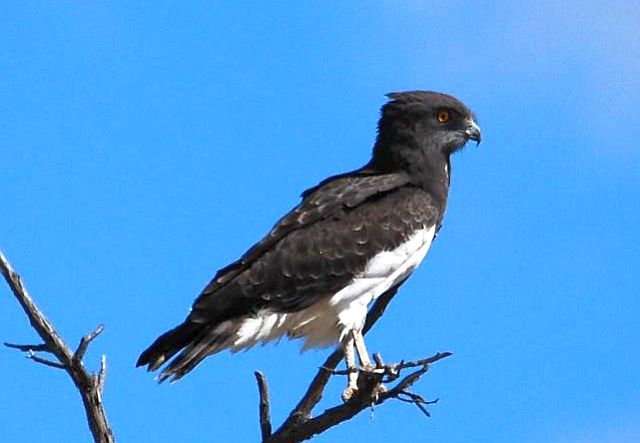 © Mel
© Mel
Kgalagadi Transfrontier Park
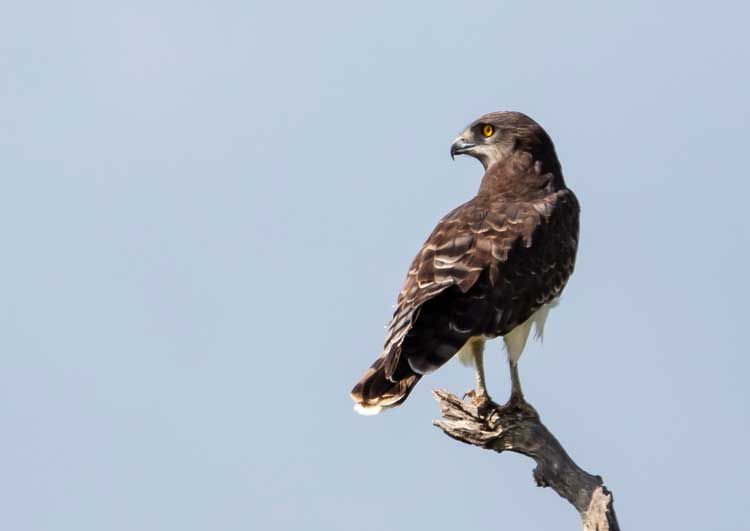 © Pumbaa
© Pumbaa
Kruger National Park
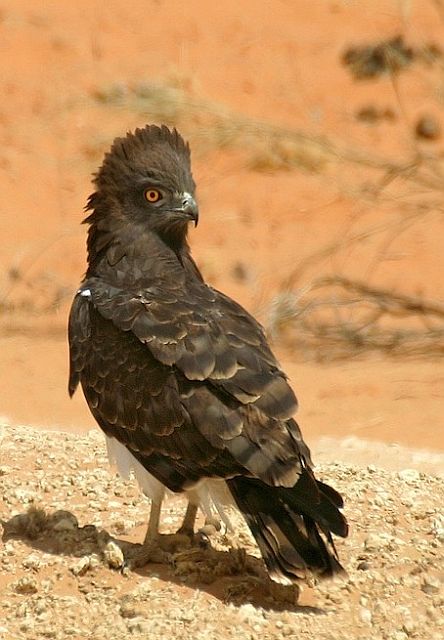 © ExFmem
© ExFmem
Kgalagadi Transfrontier Park
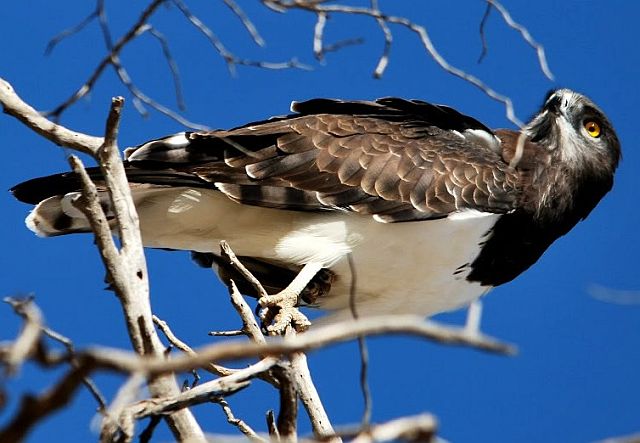
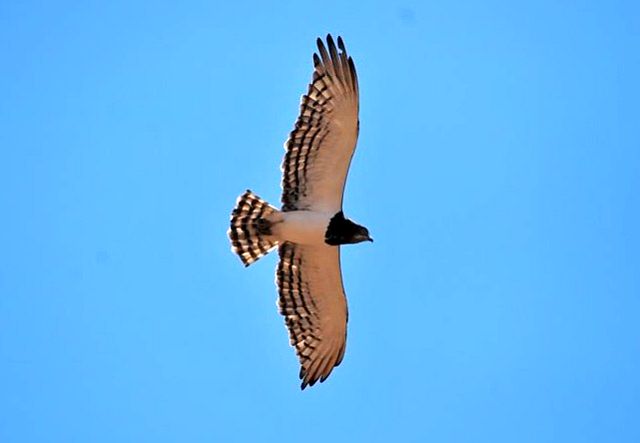
 © Duke
© Duke
 © ExFmem
© ExFmem
Juvenile, Kgalagadi Transfrontier Park
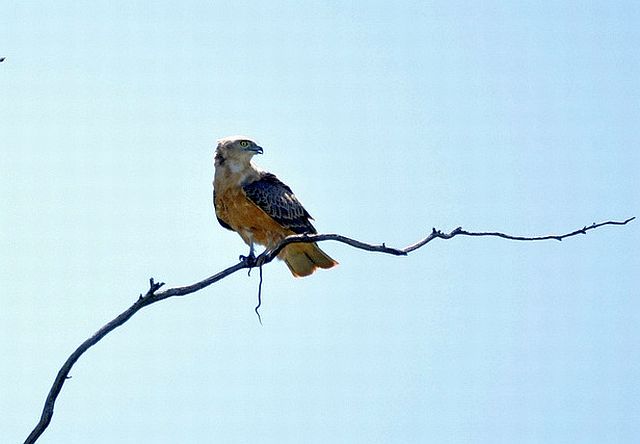 © Joan
© Joan
Juvenile
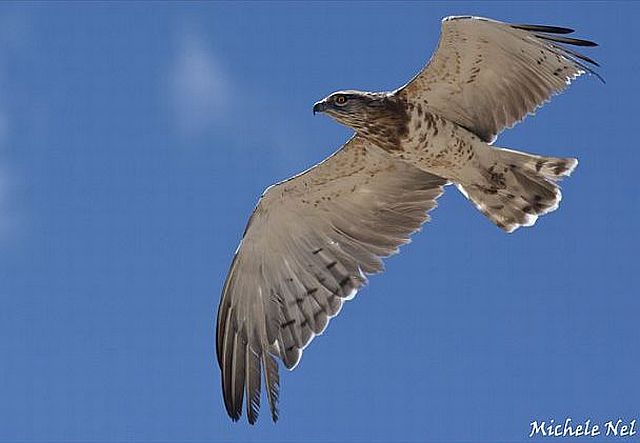 © Michele Nel
© Michele Nel
Juvenile
 © ExFmem
© ExFmem
 © ExFmem
© ExFmem
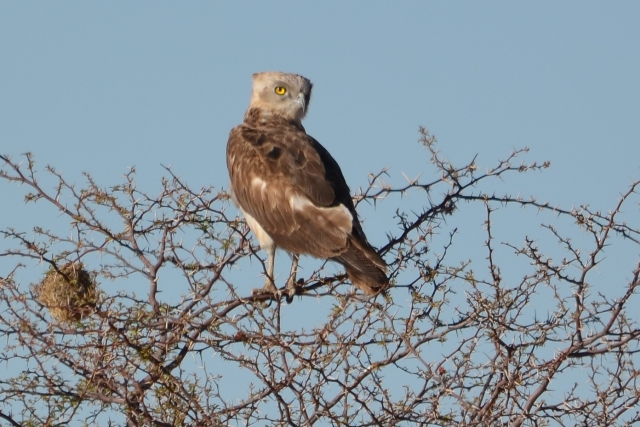 © Mel
© Mel
Juvenile
Links:
http://sabap2.adu.org.za/docs/sabap1/143.pdf
http://sabap2.adu.org.za/spp_summary.ph ... §ion=3
http://www.globalraptors.org/grin/Speci ... pecID=8202
http://www.oiseaux-birds.com/card-black ... eagle.html
 © Mel
© MelKgalagadi Transfrontier Park
 © Pumbaa
© PumbaaKruger National Park
 © ExFmem
© ExFmemKgalagadi Transfrontier Park


 © Duke
© Duke © ExFmem
© ExFmemJuvenile, Kgalagadi Transfrontier Park
 © Joan
© JoanJuvenile
 © Michele Nel
© Michele NelJuvenile
 © ExFmem
© ExFmem © ExFmem
© ExFmem © Mel
© MelJuvenile
Links:
http://sabap2.adu.org.za/docs/sabap1/143.pdf
http://sabap2.adu.org.za/spp_summary.ph ... §ion=3
http://www.globalraptors.org/grin/Speci ... pecID=8202
http://www.oiseaux-birds.com/card-black ... eagle.html
God put me on earth to accomplish a certain amount of things. Right now I'm so far behind that I'll never die.
- Flutterby
- Posts: 44150
- Joined: Sat May 19, 2012 12:28 pm
- Country: South Africa
- Location: Gauteng, South Africa
- Contact:
Brown Snake-eagle
142. Brown Snake-eagle Circaetus cinereus (Bruinslangarend)
ORDER ACCIPITRIFORMES. Family: Accipitridae
Description
Has an overall brown body with creamy-white, three narrow grey bars on white tipped tail, slight crest, unfeathered white legs and large yellow eyes, pale grey cere, black beak. Upright stance when perched. In flight the dark brown underwing coverts contrast with white primaries and secondaries with barred tail.
Sexes and juveniles are alike.
Similar species: It is distinguished from all other dark brown eagles by its unfeathered, creamy white legs.
Distribution
Occupies much of sub-Saharan Africa, excluding the lowland forest of West Africa. In southern Africa, it is locally common across Mozambique, northern and eastern South Africa, Zimbabwe, Botswana and the northern half of Namibia (including the Caprivi Strip).
Habitat
Most dry woodland habitats.
Diet
Mainly snakes (including large poisonous species such as puffadder, mamba, boomslang, grass snakes), also monitor lizards, lizards and chameleons.
Breeding
Monogamous. Stick nest usually placed in top of flat-topped trees. The single large, round, white egg is incubated by the female for 45 days.
Call
Hoarse kok kok kok kaw usually given in flight.
Status
Locally common resident, nomadic in some areas in non-breading season.
ORDER ACCIPITRIFORMES. Family: Accipitridae
Description
Has an overall brown body with creamy-white, three narrow grey bars on white tipped tail, slight crest, unfeathered white legs and large yellow eyes, pale grey cere, black beak. Upright stance when perched. In flight the dark brown underwing coverts contrast with white primaries and secondaries with barred tail.
Sexes and juveniles are alike.
Similar species: It is distinguished from all other dark brown eagles by its unfeathered, creamy white legs.
Distribution
Occupies much of sub-Saharan Africa, excluding the lowland forest of West Africa. In southern Africa, it is locally common across Mozambique, northern and eastern South Africa, Zimbabwe, Botswana and the northern half of Namibia (including the Caprivi Strip).
Habitat
Most dry woodland habitats.
Diet
Mainly snakes (including large poisonous species such as puffadder, mamba, boomslang, grass snakes), also monitor lizards, lizards and chameleons.
Breeding
Monogamous. Stick nest usually placed in top of flat-topped trees. The single large, round, white egg is incubated by the female for 45 days.
Call
Hoarse kok kok kok kaw usually given in flight.
Status
Locally common resident, nomadic in some areas in non-breading season.
- Flutterby
- Posts: 44150
- Joined: Sat May 19, 2012 12:28 pm
- Country: South Africa
- Location: Gauteng, South Africa
- Contact:
Brown Snake-eagle Photos
142. Brown Snake-eagle Circaetus cinereus
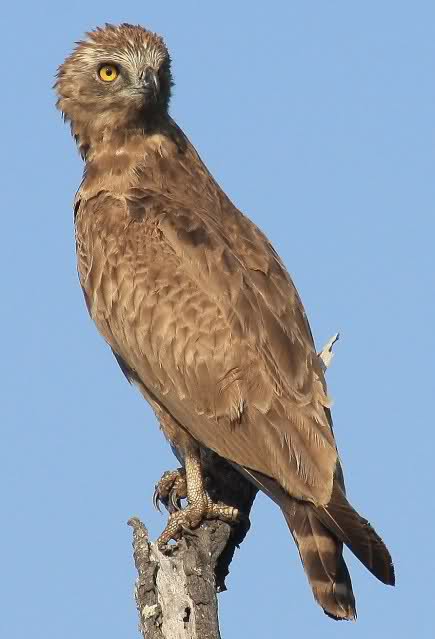 © Flutterby
© Flutterby
Immature
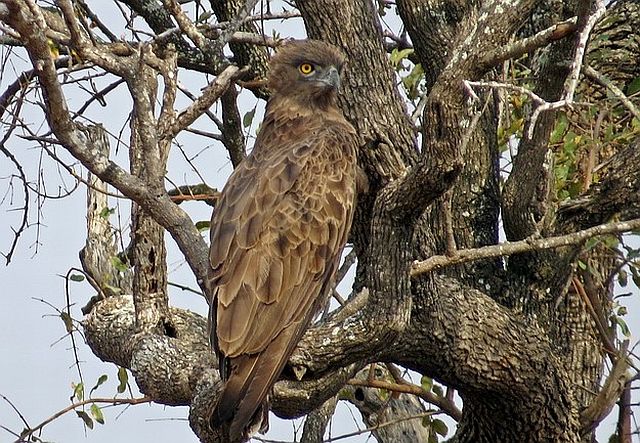 © Bushcraft
© Bushcraft
Kruger National Park S40
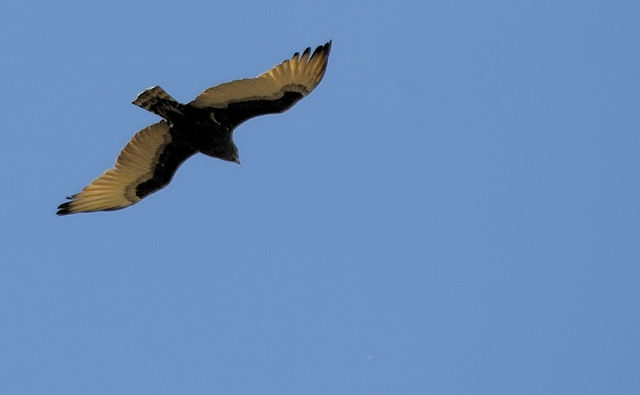 © Dewi
© Dewi
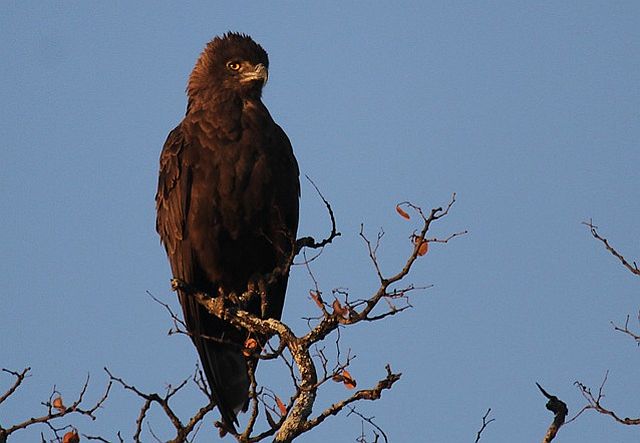 © leachy
© leachy
Kruger National Park
 © BluTuna
© BluTuna
A Brown Snake-Eagle with Blind Snake kill.
Links:
http://sabap2.adu.org.za/docs/sabap1/142.pdf
http://sabap2.adu.org.za/spp_summary.ph ... §ion=3
Sasol Birds of Prey of Africa
http://www.globalraptors.org/grin/Speci ... pecID=8199
http://www.oiseaux-birds.com/card-brown ... eagle.html
 © Flutterby
© FlutterbyImmature
 © Bushcraft
© BushcraftKruger National Park S40
 © Dewi
© Dewi © leachy
© leachyKruger National Park
 © BluTuna
© BluTunaA Brown Snake-Eagle with Blind Snake kill.
Links:
http://sabap2.adu.org.za/docs/sabap1/142.pdf
http://sabap2.adu.org.za/spp_summary.ph ... §ion=3
Sasol Birds of Prey of Africa
http://www.globalraptors.org/grin/Speci ... pecID=8199
http://www.oiseaux-birds.com/card-brown ... eagle.html
Southern Banded Snake-eagle
144. Southern Banded Snake-eagle Circaetus fasciolatus (Dubbelbandslangarend)
Order: Accipitriformes. Family: Accipitridae
Description
55-60 cm. Small and relatively inconspicuous eagle with large, rounded head. The plumage is grey-brown with white barring from lower breast to belly and thighs. The tail is longish and extends well beyond the wingtips when at rest. In flight the tail shows three dark bars and two white bars. The wings are mainly blackish-brown above. The underwing is whitish, barred with blackish and with a dark trailing edge. It has cream or pale yellow eyes, yellow feet and a sharply pointed bill which is black at the tip and yellow towards the base. Sexes are alike.
The juvenile has mainly dark upperparts and pale underparts, with dark streaks on the face, throat and upper breast. The wing-coverts have white tips and there are narrow black streaks along the throat. There is brown barring on the flanks and thighs and they have five brown bars on the tail.
Similar species: Adult resembles adult African Cuckoo Hawk but is much larger, with a large, rounded head and relatively short tail. Adults may be confused with the Western Banded Snake Eagle, but that species is larger and has less barring and longer wings. In flight it may be distinguished from Western Banded Snake Eagle by its darker underwings and the three (not two) black bars on the tail; but ranges do not overlap.
Distribution
The Southern Banded Snake Eagles is a coastal raptor in eastern and southern Africa. It has a restricted distribution along the coastal plain of east Africa, from southern Kenya through Tanzania to Mozambique, eastern KwaZulu-Natal and eastern Zimbabwe. The Greater St Lucia Wetland Park is host to between 60 and 80 percent of the total South African population.
Habitat
It generally prefers coastal evergreen forest, sand forest, thickets and plantations. In south Africa, it is confined to the East Coast Littoral vegetation type. It is generally found within 20 km of the coast. Not often seen in flight, and usually recorded from its call or when seen perched at the edges of forests and plantations. It occurs in lowland evergreen forest.
Diet
As its name suggests this species’ preferred prey is snakes, but it will also take lizards, termite alates, large beetles, mice, and even chickens.
It does most of its foraging from a perch, scanning the surrounding vegetation for prey. If it catches a large snake, it rips it into bite-size pieces before feeding, but if it small enough it just swallows it whole and head-first.
Breeding
Monogamous and territorial, performing an aerial display in which it flies up and down while calling loudly, sometimes finish with a steep dive. The nest is built by both parents, it is 50-70 cm across, consisting of an open platform of thin sticks with a smaller inner cup, lined with fresh green sprigs. The whole structure is roughly 50-70 cm wide, and the cup is usually about 17 cm wide. It is typically placed in the main fork of a tree. Egg-laying season is from August-October. It probably lays a single reen-white, rufous-streaked egg, which is mainly incubated by the female for about 49-51 days. The male may take over for short stints, early in the incubation period. The chicks are fed by both parents on a diet of shredded snake flesh, although at first the male does most of the hunting, while the female cares for the nestling.
Call
Noisy, high-pitched call ko-ko-ko-kaw, repeatedly made when perched and in flight.
Status
Uncommon, localised resident. Classified as Near Threatened (NT) on the IUCN Red List. Vulnerable in South Africa, due its small, fragmented distribution and ongoing habitat destruction. In South Africa, where it has suffered a range reduction (no longer found in the southerly part of its former range), the total population is only 40-50 pairs.
Order: Accipitriformes. Family: Accipitridae
Description
55-60 cm. Small and relatively inconspicuous eagle with large, rounded head. The plumage is grey-brown with white barring from lower breast to belly and thighs. The tail is longish and extends well beyond the wingtips when at rest. In flight the tail shows three dark bars and two white bars. The wings are mainly blackish-brown above. The underwing is whitish, barred with blackish and with a dark trailing edge. It has cream or pale yellow eyes, yellow feet and a sharply pointed bill which is black at the tip and yellow towards the base. Sexes are alike.
The juvenile has mainly dark upperparts and pale underparts, with dark streaks on the face, throat and upper breast. The wing-coverts have white tips and there are narrow black streaks along the throat. There is brown barring on the flanks and thighs and they have five brown bars on the tail.
Similar species: Adult resembles adult African Cuckoo Hawk but is much larger, with a large, rounded head and relatively short tail. Adults may be confused with the Western Banded Snake Eagle, but that species is larger and has less barring and longer wings. In flight it may be distinguished from Western Banded Snake Eagle by its darker underwings and the three (not two) black bars on the tail; but ranges do not overlap.
Distribution
The Southern Banded Snake Eagles is a coastal raptor in eastern and southern Africa. It has a restricted distribution along the coastal plain of east Africa, from southern Kenya through Tanzania to Mozambique, eastern KwaZulu-Natal and eastern Zimbabwe. The Greater St Lucia Wetland Park is host to between 60 and 80 percent of the total South African population.
Habitat
It generally prefers coastal evergreen forest, sand forest, thickets and plantations. In south Africa, it is confined to the East Coast Littoral vegetation type. It is generally found within 20 km of the coast. Not often seen in flight, and usually recorded from its call or when seen perched at the edges of forests and plantations. It occurs in lowland evergreen forest.
Diet
As its name suggests this species’ preferred prey is snakes, but it will also take lizards, termite alates, large beetles, mice, and even chickens.
It does most of its foraging from a perch, scanning the surrounding vegetation for prey. If it catches a large snake, it rips it into bite-size pieces before feeding, but if it small enough it just swallows it whole and head-first.
Breeding
Monogamous and territorial, performing an aerial display in which it flies up and down while calling loudly, sometimes finish with a steep dive. The nest is built by both parents, it is 50-70 cm across, consisting of an open platform of thin sticks with a smaller inner cup, lined with fresh green sprigs. The whole structure is roughly 50-70 cm wide, and the cup is usually about 17 cm wide. It is typically placed in the main fork of a tree. Egg-laying season is from August-October. It probably lays a single reen-white, rufous-streaked egg, which is mainly incubated by the female for about 49-51 days. The male may take over for short stints, early in the incubation period. The chicks are fed by both parents on a diet of shredded snake flesh, although at first the male does most of the hunting, while the female cares for the nestling.
Call
Noisy, high-pitched call ko-ko-ko-kaw, repeatedly made when perched and in flight.
Status
Uncommon, localised resident. Classified as Near Threatened (NT) on the IUCN Red List. Vulnerable in South Africa, due its small, fragmented distribution and ongoing habitat destruction. In South Africa, where it has suffered a range reduction (no longer found in the southerly part of its former range), the total population is only 40-50 pairs.
Southern Banded Snake-eagle Photos
144. Southern Banded Snake-eagle Circaetus fasciolatus (Dubbelbandslangarend)
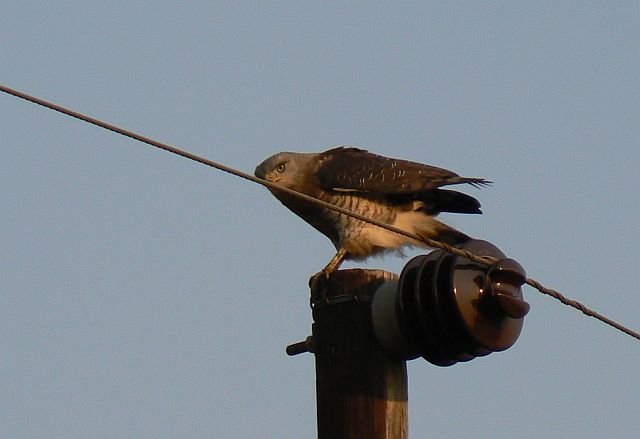
iSimangaliso
Links:
Species text Sabap1
Sabap2
Global Raptor Information Network
ARKive: http://www.arkive.org/southern-banded-s ... sciolatus/

iSimangaliso
Links:
Species text Sabap1
Sabap2
Global Raptor Information Network
ARKive: http://www.arkive.org/southern-banded-s ... sciolatus/
Western Banded Snake-eagle
145. Western Banded Snake-eagle Circaetus cinerascens (Enkelbandslangarend)
Order: Accipitriformes. Family: Accipitridae
Description
Length: 50-58 cm. Wingspan: 120-134 cm. Weight: 1.1 kg.
Appears squat, large-headed, short-tailed and plain grey-brown, apart from white tail band.
Western Banded Snake Eagles are gray-brown with white barring along the flanks, belly, and thighs. The cheeks and throat are pale in color. The tail is black and has a white tip and central band, and the flight feathers are barred with black trailing edges. There are white patches at the base of the primary feathers. Females are usually darker in plumage than males. The base of the beak is orange-yellow and the eyes and legs are yellow.
Juveniles are brown from above with a cream-buff underside and a dark breast. There is spotted and barring on the belly and thighs and the tail is light brown with a dark brown subterminal band. The cere is yellow and the legs are pale white-yellow.
Similar species: Differs from similar Southern Banded Snake Eagle by being stockier, less heavily barred below, and by having a shorter tail with a diagnostic broad white band across the middle
Distribution
Occurs in sub-Saharan Africa, largely absent from the lowland forests of the DRC and other west African countries In southern Africa it is uncommon in northern Botswana, the Caprivi Strip (Namibia), northern Zimbabwe and northern Mozambique,
Habitat
Riverine forest and woodland, such as tall Mopane (Colosphermum mopane) woodland in the Zambezi River valley; it occasionally hunts in adjacent open habitats.
Diet
It mainly eats snakes (especially arboreal ones), doing most of its hunting from a perch, where it stays immobile for hours while searching for prey. Once it spots something, it glides to the ground or tree canopy and plucks the animal up, before returning its perch to feed.
Breeding
Probably a monogamous solitary nester, performing spectacular aerial displays in the run-up to the breeding season. The nest is a platform of sticks with a cup set into it, lined with green leaves such as Munondo (Julbernadia globiflora). It is typically placed about 10-18 m above ground, in the canopy of a large tree. Egg-laying season is from about December to February. It lays a single egg, which is incubated for an estimated period of 36-42 days. The chick is fed by both parents, leaving the nest after approximately 56 days.
Call
Western Banded Snake Eagles often call when perched. Their main call is a low, croaking kok kok kok kok ko ho.
Status
Locally common to rare resident.
Order: Accipitriformes. Family: Accipitridae
Description
Length: 50-58 cm. Wingspan: 120-134 cm. Weight: 1.1 kg.
Appears squat, large-headed, short-tailed and plain grey-brown, apart from white tail band.
Western Banded Snake Eagles are gray-brown with white barring along the flanks, belly, and thighs. The cheeks and throat are pale in color. The tail is black and has a white tip and central band, and the flight feathers are barred with black trailing edges. There are white patches at the base of the primary feathers. Females are usually darker in plumage than males. The base of the beak is orange-yellow and the eyes and legs are yellow.
Juveniles are brown from above with a cream-buff underside and a dark breast. There is spotted and barring on the belly and thighs and the tail is light brown with a dark brown subterminal band. The cere is yellow and the legs are pale white-yellow.
Similar species: Differs from similar Southern Banded Snake Eagle by being stockier, less heavily barred below, and by having a shorter tail with a diagnostic broad white band across the middle
Distribution
Occurs in sub-Saharan Africa, largely absent from the lowland forests of the DRC and other west African countries In southern Africa it is uncommon in northern Botswana, the Caprivi Strip (Namibia), northern Zimbabwe and northern Mozambique,
Habitat
Riverine forest and woodland, such as tall Mopane (Colosphermum mopane) woodland in the Zambezi River valley; it occasionally hunts in adjacent open habitats.
Diet
It mainly eats snakes (especially arboreal ones), doing most of its hunting from a perch, where it stays immobile for hours while searching for prey. Once it spots something, it glides to the ground or tree canopy and plucks the animal up, before returning its perch to feed.
Breeding
Probably a monogamous solitary nester, performing spectacular aerial displays in the run-up to the breeding season. The nest is a platform of sticks with a cup set into it, lined with green leaves such as Munondo (Julbernadia globiflora). It is typically placed about 10-18 m above ground, in the canopy of a large tree. Egg-laying season is from about December to February. It lays a single egg, which is incubated for an estimated period of 36-42 days. The chick is fed by both parents, leaving the nest after approximately 56 days.
Call
Western Banded Snake Eagles often call when perched. Their main call is a low, croaking kok kok kok kok ko ho.
Status
Locally common to rare resident.
Western Banded Snake-eagle Photos
145. Western Banded Snake-eagle Circaetus cinerascens (Enkelbandslangarend)
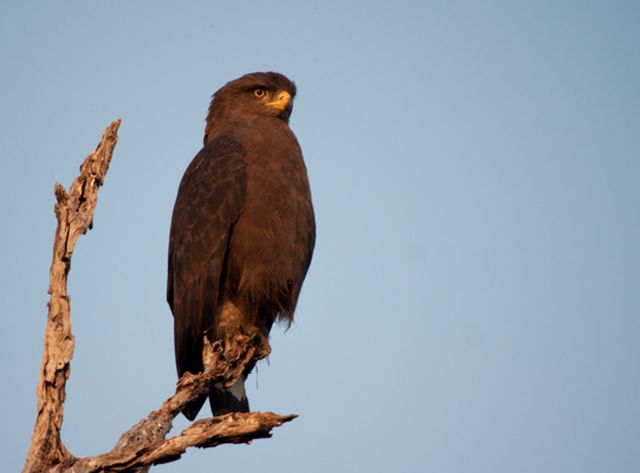 © Kesheshe
© Kesheshe
South Luangwa National Park, Zambia
Links:
Species text Sabap1
Sabap2: http://sabap2.adu.org.za/spp_summary.ph ... §ion=3
Sasol Birds of Prey of Africa and Its Islands
Newman's Birds of Southern Africa
 © Kesheshe
© KeshesheSouth Luangwa National Park, Zambia
Links:
Species text Sabap1
Sabap2: http://sabap2.adu.org.za/spp_summary.ph ... §ion=3
Sasol Birds of Prey of Africa and Its Islands
Newman's Birds of Southern Africa
- Bushveld Jock
- Posts: 2001
- Joined: Sat Jun 02, 2012 3:52 pm
- Contact:
Bateleur
146. Bateleur Terathopius ecaudatus (Berghaan)
ORDER ACCIPITRIFORMES. Family: Accipitridae
Description
Length 55-70 cm, wingspan 1.8 m; weight 2.25 kg. Yellow eye; yellow beak; unfeathered legs and short tail.
Adult: Head, neck, breast, greater upperwing-coverts and belly are black, lesser wing-coverts tend toward brown with whitish edges. Back, undertail-coverts and tail are a chestnut colour, underwing-coverts are white. Its brown eyes are surrounded by red facial skin. The legs are brilliant red. When perched, the male's secondaries are black,those of the female are a very light greyish colour.
Juvenile: generally brown plumage and lack red on the bare facial skin.
Flight pattern: Short tail, shorter in adult than in juvenile/immature birds.Toes extend beyond tail tip. It has 25 secondaries. Immature birds show greyish remiges with blackish fingers and a dark subterminal band at the trailing edge of the wing and the greater upperwing coverts form a dark band across the wing.
In flight there is a broad black trailing edge under the wings of the male, whereas the female shows a narrow black trailing edge.
Distribution
Widely over sub-Saharan Africa from Senegal east to Sudan, Ethiopia and western Somalia and south to Botswana, North-Eastern Namibia, Zimbabwe, Mozambique, northern South Africa.
Habitat
Savanna and woodland in large protected areas. Often seen on ground at waterholes.
Diet
It is mainly a scavenger, although about a third of its time is spent hunting, feeding on a variety of animals: rodents, mongooses, genets, birds, snakes, lizards, tortoises and terrapins, chameleons, fish, frogs, insects.
Breeding
Pairing is for life, and a pair will use the same nest tree and nest for a number of years. The nest is often in a riparian zone in a large tree, especially thorny acacia. It is of heavy sticks with a deep cup lined with green leaves. Both sexes build the nest, and the male assists at times in the incubation and brooding. Egg-laying season is year-round, peaking from January-April. One unspotted, chalky-white egg is laid. It is incubated for 52-55 days, but is often left unattended while both parents forage. The male may feed the female near the nest. Both sexes bring food to the chick. The chick's first flight is usually around 110-115 days.
Call
It utters short kau-kau-kau repeated and followed by two mostly long koaagh.
Status
Common resident. Not globally threatened, but Vulnerable in South Africa and Namibia, as its population in these countries is decreasing and it's range is contracting. It is now restricted to protected areas, as it often falls victim to persecution as well as dying from poisoned bait put out for jackals.
ORDER ACCIPITRIFORMES. Family: Accipitridae
Description
Length 55-70 cm, wingspan 1.8 m; weight 2.25 kg. Yellow eye; yellow beak; unfeathered legs and short tail.
Adult: Head, neck, breast, greater upperwing-coverts and belly are black, lesser wing-coverts tend toward brown with whitish edges. Back, undertail-coverts and tail are a chestnut colour, underwing-coverts are white. Its brown eyes are surrounded by red facial skin. The legs are brilliant red. When perched, the male's secondaries are black,those of the female are a very light greyish colour.
Juvenile: generally brown plumage and lack red on the bare facial skin.
Flight pattern: Short tail, shorter in adult than in juvenile/immature birds.Toes extend beyond tail tip. It has 25 secondaries. Immature birds show greyish remiges with blackish fingers and a dark subterminal band at the trailing edge of the wing and the greater upperwing coverts form a dark band across the wing.
In flight there is a broad black trailing edge under the wings of the male, whereas the female shows a narrow black trailing edge.
Distribution
Widely over sub-Saharan Africa from Senegal east to Sudan, Ethiopia and western Somalia and south to Botswana, North-Eastern Namibia, Zimbabwe, Mozambique, northern South Africa.
Habitat
Savanna and woodland in large protected areas. Often seen on ground at waterholes.
Diet
It is mainly a scavenger, although about a third of its time is spent hunting, feeding on a variety of animals: rodents, mongooses, genets, birds, snakes, lizards, tortoises and terrapins, chameleons, fish, frogs, insects.
Breeding
Pairing is for life, and a pair will use the same nest tree and nest for a number of years. The nest is often in a riparian zone in a large tree, especially thorny acacia. It is of heavy sticks with a deep cup lined with green leaves. Both sexes build the nest, and the male assists at times in the incubation and brooding. Egg-laying season is year-round, peaking from January-April. One unspotted, chalky-white egg is laid. It is incubated for 52-55 days, but is often left unattended while both parents forage. The male may feed the female near the nest. Both sexes bring food to the chick. The chick's first flight is usually around 110-115 days.
Call
It utters short kau-kau-kau repeated and followed by two mostly long koaagh.
Status
Common resident. Not globally threatened, but Vulnerable in South Africa and Namibia, as its population in these countries is decreasing and it's range is contracting. It is now restricted to protected areas, as it often falls victim to persecution as well as dying from poisoned bait put out for jackals.
Kgalagadi: Dec 2015
KNP Maroela, Shingwedzi & Pretoriuskop: March 2016
KNP Maroela, Shingwedzi & Pretoriuskop: March 2016
- Bushveld Jock
- Posts: 2001
- Joined: Sat Jun 02, 2012 3:52 pm
- Contact:
Bateleur Photos
146. Bateleur Terathopius ecaudatus
 © Pumbaa
© Pumbaa
Kruger National Park
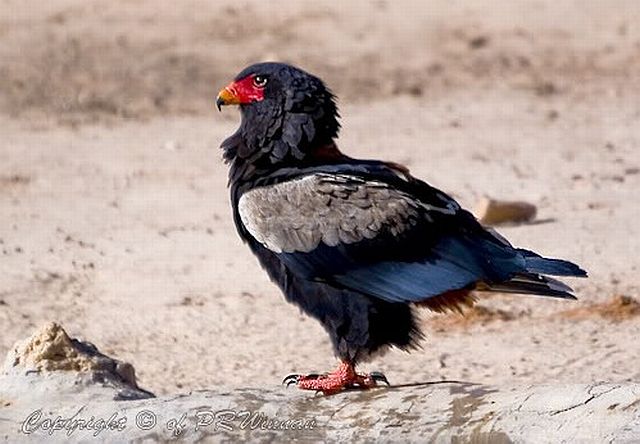
 © Mel
© Mel
 Female © Dewi
Female © Dewi
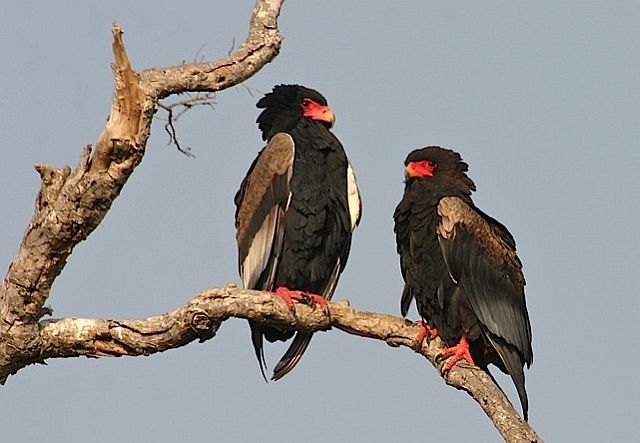 Female & male © ExFmem
Female & male © ExFmem
 © leachy
© leachy
Juvenile
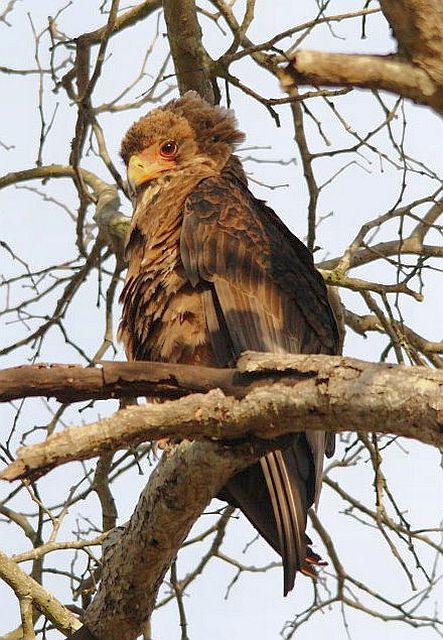 © Flutterby
© Flutterby
Juvenile
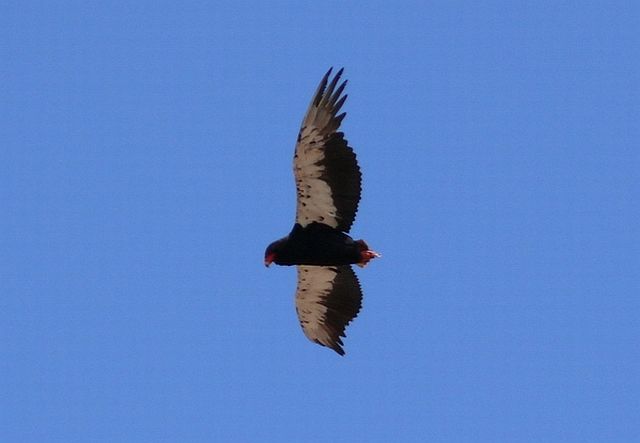 © Supernova
© Supernova
Male
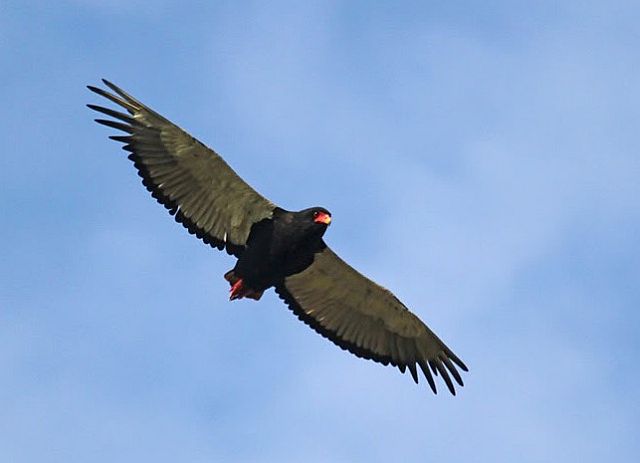 © leachy
© leachy
Female (narrower black trailing edge to wings)
 © leachy
© leachy
Juvenile
 © Dewi
© Dewi
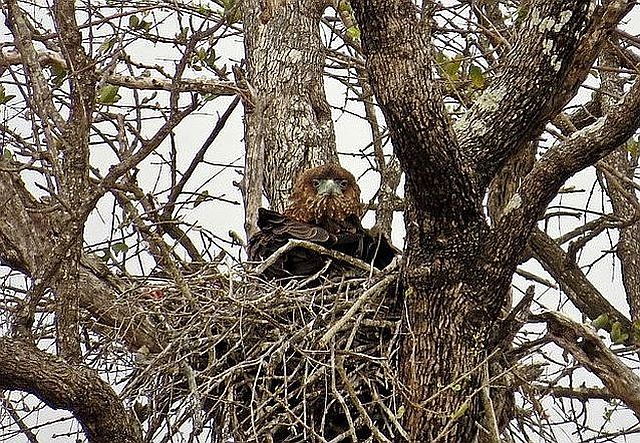 © Bushcraft
© Bushcraft
Kruger National Park H10
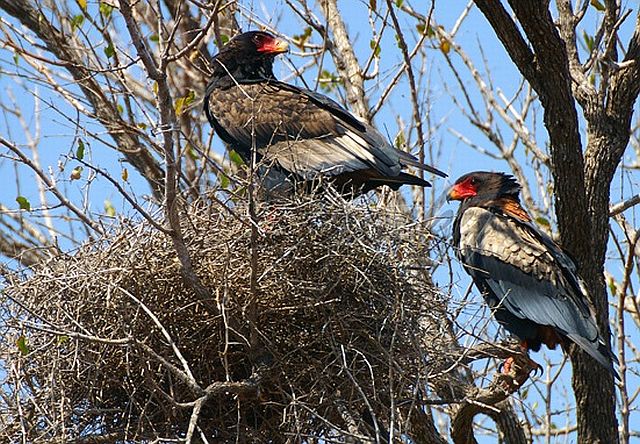 © Sprocky
© Sprocky
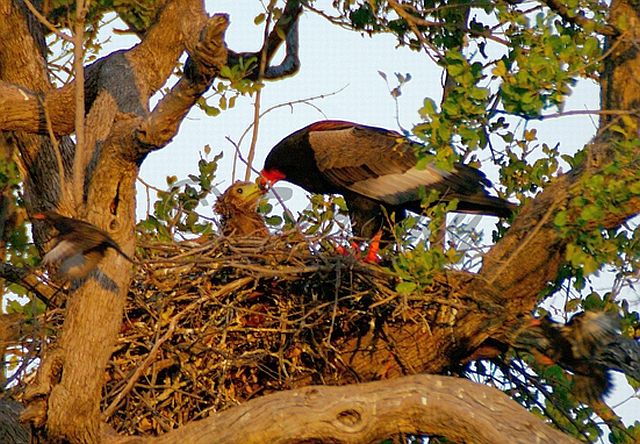 © Sprocky
© Sprocky
Links:
http://sabap2.adu.org.za/docs/sabap1/146.pdf
http://sabap2.adu.org.za/spp_summary.ph ... §ion=3
http://www.robertsonline.co.za/bird/33720/33720-1.asp
http://www.globalraptors.org/grin/Speci ... pecID=8342
http://www.oiseaux-birds.com/card-bateleur.html
 © Pumbaa
© PumbaaKruger National Park

 © Mel
© Mel Female © Dewi
Female © Dewi Female & male © ExFmem
Female & male © ExFmem © leachy
© leachyJuvenile
 © Flutterby
© FlutterbyJuvenile
 © Supernova
© SupernovaMale
 © leachy
© leachyFemale (narrower black trailing edge to wings)
 © leachy
© leachyJuvenile
 © Dewi
© Dewi © Bushcraft
© BushcraftKruger National Park H10
 © Sprocky
© Sprocky © Sprocky
© SprockyLinks:
http://sabap2.adu.org.za/docs/sabap1/146.pdf
http://sabap2.adu.org.za/spp_summary.ph ... §ion=3
http://www.robertsonline.co.za/bird/33720/33720-1.asp
http://www.globalraptors.org/grin/Speci ... pecID=8342
http://www.oiseaux-birds.com/card-bateleur.html
Kgalagadi: Dec 2015
KNP Maroela, Shingwedzi & Pretoriuskop: March 2016
KNP Maroela, Shingwedzi & Pretoriuskop: March 2016


